
The regions of Italy are the first-level administrative divisions of the Italian Republic, constituting its second NUTS administrative level. There are twenty regions, five of which are autonomous regions with special status. Under the Constitution of Italy, each region is an autonomous entity with defined powers. With the exception of the Aosta Valley and Friuli-Venezia Giulia (2018–2020), each region is divided into a number of provinces.

The Senate of the Republic, or simply the Senate, is the upper house of the bicameral Italian Parliament, the lower house being the Chamber of Deputies. The two houses together form a perfect bicameral system, meaning they perform identical functions, but do so separately. Pursuant to the Articles 57, 58, and 59 of the Italian Constitution, the Senate has 200 elective members, of which 196 are elected from Italian constituencies, and 4 from Italian citizens living abroad. Furthermore, there is a small number of senators for life, either appointed or ex officio. It was established in its current form on 8 May 1948, but previously existed during the Kingdom of Italy as Senato del Regno, itself a continuation of the Senato Subalpino of Sardinia established on 8 May 1848. Members of the Senate are styled Senator or The Honourable Senator and they meet at Palazzo Madama, Rome.

The Chamber of Deputies is the lower house of the bicameral Italian Parliament, the upper house being the Senate of the Republic. The two houses together form a perfect bicameral system, meaning they perform identical functions, but do so separately. The Chamber of Deputies has 400 seats, of which 392 are elected from Italian constituencies, and 8 from Italian citizens living abroad. Deputies are styled The Honourable and meet at Palazzo Montecitorio.

National-level elections in Italy are called periodically to form a parliament consisting of two houses: the Chamber of Deputies with 400 members; and the Senate of the Republic with 200 elected members, plus a few appointed senators for life. Italy is a parliamentary republic: the President of the Republic is elected for a seven-year term by the two houses of Parliament in joint session, together with special electors appointed by the Regional Councils.

Aosta Valley is a regionalist coalition of parties active in Aosta Valley, Italy.

A snap election was held in Italy on 13–14 April 2008. The election came after President Giorgio Napolitano dissolved the Italian Parliament on 6 February 2008, following the defeat of the government of Prime Minister Romano Prodi in a January 2008 Senate vote of confidence and the unsuccessful tentative appointment of Franco Marini with the aim to change the current electoral law. Under Italian law, elections must be held within 70 days of the dissolution. The voting determined the leader of Italy's 62nd government since the end of World War II. The coalition led by ex-Prime Minister Silvio Berlusconi from The People of Freedom party defeated that of former Mayor of Rome, Walter Veltroni of the Democratic Party.

The 2013 Italian general election was held on 24 and 25 February 2013 to determine the 630 members of the Chamber of Deputies and the 315 elective members of the Senate of the Republic for the 17th Italian Parliament. The centre-left alliance Italy Common Good, led by the Democratic Party (PD), obtained a clear majority of seats in the Chamber of Deputies thanks to a majority bonus that effectively trebled the number of seats assigned to the winning force and narrowly defeated the centre-right alliance of former prime minister Silvio Berlusconi in the popular vote. Close behind, the new anti-establishment Five Star Movement of comedian Beppe Grillo became the third force, well ahead of the centrist coalition of outgoing Prime Minister Mario Monti. In the Senate, no political group or party won an outright majority, resulting in a hung parliament.

The Italian electoral law of 2015, also known as Italicum, was an Italian electoral law passed in 2015. The law, which came into force on 1 July 2016, regulated only the election of the Chamber of Deputies, replacing the Italian electoral law of 2005, which had been ruled partly unconstitutional by the Constitutional Court of Italy in December 2013. It provided for a two-round system based on party-list proportional representation, including a majority bonus and a 3% election threshold. Candidates would have run in 100 multi-member constituencies using open lists. The largest party which won over 40% of the vote would automatically win a majority of seats; if no party won 40% of seats, a second round of voting would be held between the two largest parties, with the winner of the second round winning a majority of seats. The name "Italicum" was coined in 2014 by Democratic Party secretary and later Prime Minister of Italy, Matteo Renzi, who was one of the legislation's main proponent.

The Italian electoral law of 2017, colloquially known by the nickname Rosatellum after Ettore Rosato, the Democratic Party (PD) leader in the Chamber of Deputies who first proposed the new law, is a parallel voting system, which acts as a mixed electoral system, with 37% of seats allocated using a first-past-the-post electoral system and 63% using a proportional method, with one round of voting. The Chamber and Senate of the Republic did not differ in the way they allocated the proportional seats, both using the largest remainder method of allocating seats.

Carlo Fidanza is an Italian politician who has served as a Member of the European Parliament (MEP) since 2019, previously holding a seat from 2009 to 2014. He is a member of Brothers of Italy (FdI).

The law no. 270 of 21 December 2005 was a proportional electoral law with a majority prize and blocked lists that regulated the election of the Chamber of Deputies and the Senate in Italy in 2006, 2008 and 2013.

The 2020 Valdostan regional election took place on 20 and 21 September 2020 in Aosta Valley, Italy. The election was originally scheduled to take place on 19 April 2020, but was then postponed first to 10 May and then delayed for a second time due to the coronavirus pandemic in Italy.

Emilia-Romagna is one of the 29 constituencies represented in the Chamber of Deputies, the lower house of the Italian parliament. The constituency currently elects 29 deputies, more than any other in the parliament. Its boundaries correspond to those of the Italian region of Emilia-Romagna. The electoral system uses a parallel voting system, which act as a mixed system, with 37% of seats allocated using a first-past-the-post electoral system and 61% using a proportional method, with one round of voting.
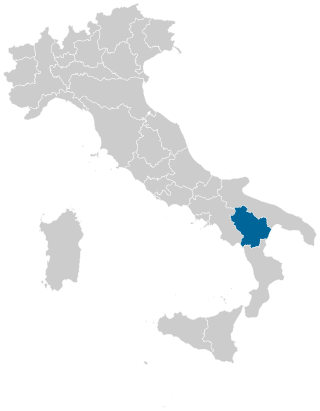
Basilicata is one of the 29 constituencies represented in the Chamber of Deputies, the lower house of the Italian parliament. The constituency currently elects 6 deputies. Its boundaries correspond to those of the Italian region of Basilicata. The electoral system uses a parallel voting system, which act as a mixed system, with 37% of seats allocated using a first-past-the-post electoral system and 61% using a proportional method, with one round of voting.
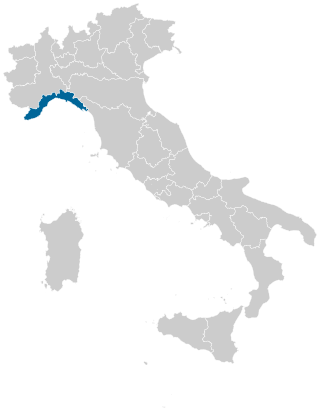
Liguria is one of the 29 constituencies represented in the Chamber of Deputies, the lower house of the Italian parliament. The constituency currently elects 16 deputies. Its boundaries correspond to those of the Italian region of Liguria. The electoral system uses a parallel voting system, which act as a mixed system, with 37% of seats allocated using a first-past-the-post electoral system and 61% using a proportional method, with one round of voting.
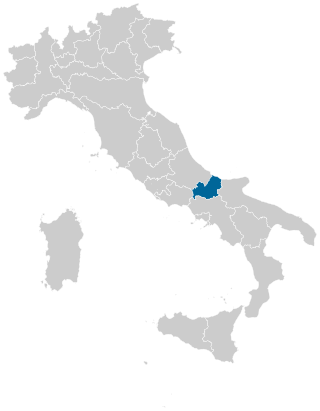
Molise is one of the 29 constituencies represented in the Chamber of Deputies, the lower house of the Italian parliament. The constituency currently elects 2 deputies, less than any other except Aosta Valley. Its boundaries correspond to those of the Italian region of Molise. The electoral system uses a parallel voting system, which act as a mixed system, with half of seats allocated using a first-past-the-post electoral system and half using a proportional method, with one round of voting.

Sardinia is one of the 29 constituencies represented in the Chamber of Deputies, the lower house of the Italian parliament. The constituency currently elects 17 deputies. Its boundaries correspond to those of the Italian region of Sardinia. The electoral system uses a parallel voting system, which act as a mixed system, with 37% of seats allocated using a first-past-the-post electoral system and 61% using a proportional method, with one round of voting.
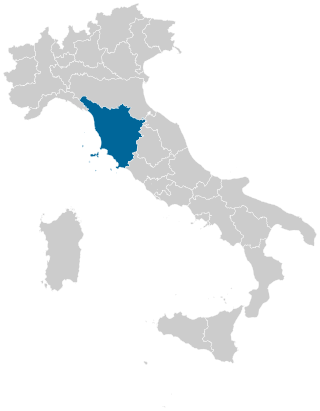
Tuscany is one of the 29 constituencies represented in the Chamber of Deputies, the lower house of the Italian parliament. The constituency currently elects 39 deputies. Its boundaries correspond to those of the Italian region of Tuscany. The electoral system uses a parallel voting system, which act as a mixed system, with 37% of seats allocated using a first-past-the-post electoral system and 61% using a proportional method, with one round of voting.

Umbria is one of the 29 constituencies represented in the Chamber of Deputies, the lower house of the Italian parliament. The constituency currently elects 9 deputies. Its boundaries correspond to those of the Italian region of Umbria. The electoral system uses a parallel voting system, which act as a mixed system, with 37% of seats allocated using a first-past-the-post electoral system and 61% using a proportional method, with one round of voting.
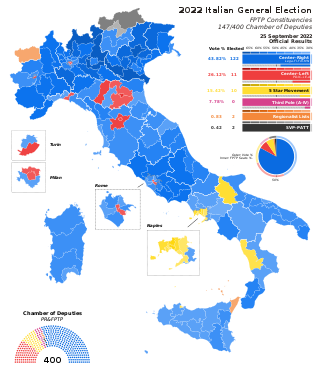
The 2022 Italian general election was held on 25 September, resulting in a majority of seats of both houses of the Italian Parliament for the centre-right coalition. The Meloni Cabinet was announced on 21 October and was officially sworn in on the next day. The first Cabinet headed by a female Prime Minister of Italy, it was variously described as a shift to the political right, as well as the first far-right-led Italian government since World War II. The Meloni Cabinet successufully won the confidence votes on 25–26 October with a comfortable majority in both houses of Parliament.


















